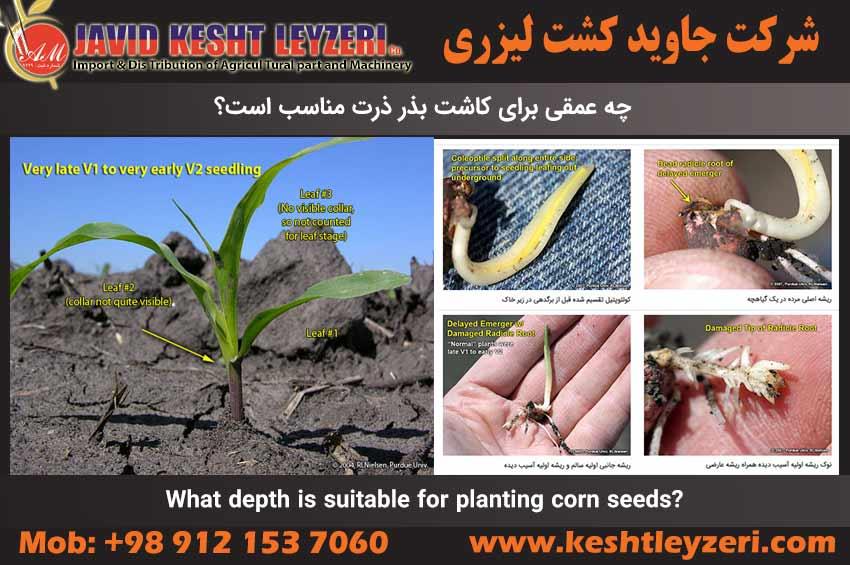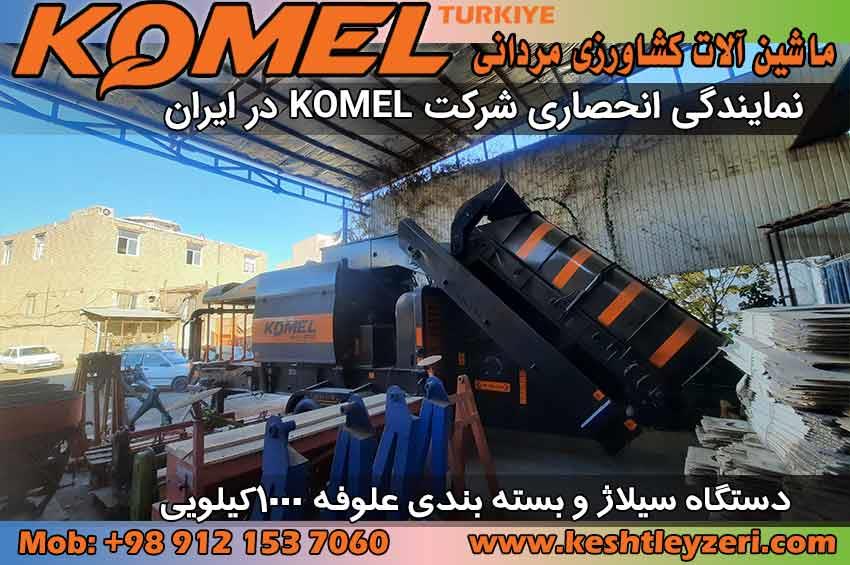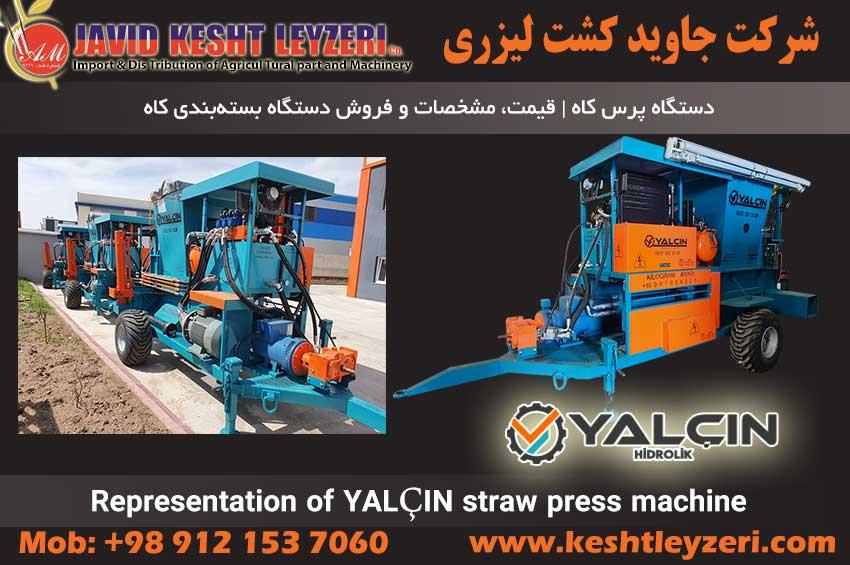
What depth is suitable for planting corn seeds?
javid keshtleyzeri Co.ltd
List of contents of this section:
What is the necessity of choosing the right depth for planting corn seeds?
What is the root structure of the corn plant?
What are the results of planting corn seeds too shallow or too deep?
What are the suitable environmental conditions for corn root growth?
In the following, the above contents will be reviewed.
What is the necessity of choosing the right depth for planting corn seeds?
One of the important factors in corn planting is the proper planting depth. For proper density in corn fields and to obtain maximum harvest, corn must be planted at the proper depth. Part of the control of corn planting is in the hands of farmers and some factors are controllable. Maize density and final yield are affected by various factors. An easy way to maintain high density in a corn field and maximize yield is to plant at the proper depth. In the matter of planting corn, the proper planting depth is very important, because it is very necessary for the growth and development of the root.
The rule in planting corn seeds is that the seeds should be planted at a depth equal to two to three index fingers. But not everyone's fingers are the same size, so more accurate measurements are important for farmers to make decisions. It should be noted that corn should be planted deeper than other crops such as rapeseed, wheat, barley, etc. Regarding the appropriate depth of seed, there are several different opinions, but in the dominant opinion, the ideal depth of corn planting is about 4 to 5 cm with 12 mm of moisture in the soil.
Most agricultural experts agree that planting corn at a depth much less than 4 cm will lead to more problems. Therefore, it is better to consider a depth of 5 cm for planting corn, according to the recommendations of our experts.
One of the main reasons why it is recommended to choose a corn planting depth of 5 cm is the very good contact between the seed and the soil. To ensure this is important at the planting board level, the seed should be planted where there is a higher moisture level stability. The non-uniformity of moisture throughout the seed presence area is the main reason for heterogeneity in seedlings in the field, which can lead to 8-10% damage.
Of course, there are always caveats and exceptions to the rules that may lead to finer adjustments. For example, if the soil conditions are dry at the time of planting, the Hiramkari method (first watering and then planting) is often used to help the uniformity of seedling growth. In the Hiramkari method, the planting depth should be set in such a way that the seed is placed in safe moisture. Soil texture is also an important factor to consider. In heavy soils with a lot of clay texture, corn seeds should be planted 6 cm deep. However, in areas where the soils are sandy and lighter, as well as hot areas, a planting depth of up to 7 cm may be necessary. Therefore, the conditions may be different in each field and it is necessary to determine the planting depth for each field. When entering the fields, experts should determine the appropriate depth of planting corn seeds for each field, according to the types of soil and different agricultural methods. Therefore, it is recommended to carefully check the conditions of each field at the time of planting and determine the appropriate planting depth. To better understand the importance of corn seed planting depth, the root structure in corn must be properly understood.
What is the root structure of the corn plant?
Before discussing the implications of planting too shallow or too deep, it is important to understand the development and structure of corn root systems. Maize has two well-known rooting systems. The first system consists of the primary root that originates from the germination of the seed. The primary root system is limited in size and efficiency, but helps the plant obtain nutrients and water.
When corn seeds are planted, water and nutrients dissolved in water are absorbed by the embryo. These nutrients participate in a series of biochemical reactions and lead to germination. The first structure that emerges from the seed is the primary root. After the main root emerges, the coleoptile (which is not a root structure) and then the primary lateral roots also emerge. The main root and primary lateral roots form the primary root (or seed root) system. The primary root system absorbs water for the growing plant, but is poor in absorbing nutrients. When the seedling reaches the soil surface, the growth of the main root system is reduced and the secondary root system is formed. Although the primary root system still does not help much in maintaining the corn plant in the long term, early damage to the main root or primary lateral roots can delay the initial growth of the seedling and delay its emergence. Of course, as long as the seed itself and the mesocotyl (the axis between the cotyledons) remain healthy, the damage will not absolutely lead to the immediate death of the seedling, but may cause a delay in the emergence or growth of the seedling under the soil. As more time passes, more secondary roots will develop and damage to the primary root system will have less effect.
Symptoms of such damage to the primary root include delay in root growth and elongation, brown discoloration of the root tissue, excessive branching of the root, and complete death of the root tissue. If the primary taproot is too severely damaged in advance of the root from the seed, the entire taproot may be lost. But when the primary main root is 1.5 cm or more in length, the damage to the root end will not lead to the destruction of the whole root, but the lateral roots of the root may react to the end of the meristem due to this damage and create a new branching (secondary root). to be
A secondary root system is a secondary root system that starts growing at individual nodes above the mesocotyl of the stem (about 1.5 to 2.5 cm below the soil surface) and progresses toward the soil surface.
. The growth of this secondary root system starts from the node of the lowest collar (young seedling), which is approximately corresponding to the appearance of the first collar leaf. Secondary root systems (2 to 10 roots per node) generally develop at all underground nodes (usually from node 5). The growth of the secondary root system coincides with the growth of the leaf collar. In other words, if the seedling has two sets of secondary roots, it is at or near the two-leaf stage. In the four-leaf stage, the secondary roots are larger and wider than the primary roots. Secondary roots can also grow from nodes above the soil surface. The increase in stem length begins between the 4- and 5-leaf stage. Elongation at the node above the fifth node usually raises the sixth node above the ground. Thus, five sets or rings of secondary roots are generally recognizable underground. The increase in the length of the primary nodes will lead to placing the remaining nodes of the stem higher than the soil. A set of secondary roots that develop at the stem nodes above ground level are commonly known as "supporting aerial roots".
If the surface soil conditions are suitable, i.e. the soil is moist and not too hot, the aerial roots have the ability to penetrate the soil and succeed in growing and multiplying. In this case, these roots can effectively extract water and nutrients from the upper layer of the soil. With the development of the secondary root system, the role of the primary root system in water absorption decreases and more attention is needed for flexible and specific secondary roots. Secondary roots play an important role in supporting the plant structure and absorbing more nutrients and water necessary for plant growth and development.
In the case of young corn, its dependence on seed reserves changes to its dependence on secondary roots until about the 3-leaf stage. If there is a harmful effect or stress on the first sets of secondary root growth during the time when the plant has from one to five leaves, the growth of corn will be severely delayed and in some cases it may definitely stop. In some cases, the effect will even be so detrimental that the plant will not be allowed to develop secondary roots and will have to over-rely on seed reserves. If the seed reserves are almost exhausted, the growth of the young plant will hardly stop and the plant may become sick and eventually die.
Factors that can stop the primary growth of secondary roots include damage from accumulated salts, seedling diseases, damage from herbicides, damage from pests, excessively wet or dry soils, soil compaction (caused by tillage or seeding).
There are special reasons for corn planting depth of 4 to 5 cm along with 12 mm of moisture in the soil. At this depth, the seed can establish a good contact with the soil, which is necessary for the absorption of water by the seed and the occurrence of germination. To absorb water, the seed must be exposed to soil moisture, and soil moisture must be uniform throughout the planting depth to result in uniform plant germination. In addition, a depth of 5 cm allows the formation of a strong secondary root system, which is necessary for the rapid growth and development of the plant.
What are the results of planting corn seeds too shallow or too deep?
Planting less than the required depth can lead to more problems in corn fields. During the growing season, the problems caused by planting to shallower depths are more common in fields. This issue can lead to the incorrect development of the secondary root system, and as a result, it reduces the absorption of water, nutrients and even plant dormancy. Reducing access to water and nutrients can stress plants and reduce their performance. If the corn does not fully develop the root and does not provide the necessary support, it will go to sleep. The weak and short root system in corn is known as rootless syndrome, which occurs due to excessive dryness of the surface soil and soil temperature during germination (2-4-leaf stage). Young roots emerging from the crown of the plant will die if the root tip (and upper regions) dry out before they are successfully established in moist soil. The growing point of a young corn plant is usually 2 cm or less below the soil surface and is particularly vulnerable to surface soil dryness.
On the other hand, planting at a lower depth can lead to a delay in the emergence of the plant, exposure to lower soil temperatures and the return of the flower to the soil. The delay in plant emergence is due to more time and energy needed for the plant to emerge from moister soil depths. At wetter depths, the soil can be cooler, resulting in delayed seed germination and greater susceptibility to soil-borne diseases and pest infestations. Maize is sensitive to cold soils and needs a temperature higher than 10 degrees Celsius for germination. Therefore, it is necessary to check the soil temperature at the proper depth before planting. Delayed emergence can lead to delayed flowering and harvest. Taking the time to determine and check planting depth in the field can minimize potential problems during the growing season.
——————————————Effect of corn seed planting depth————————————————
Planting corn seeds at a great depth. Planting corn seeds at a shallow depth
Exposed to cold soil stress, poor development of the secondary root system
Delay or non-appearance of dormant seedlings in the early season
Defoliation under soil Poor plant health from mid to late growing season
What are the suitable environmental conditions for corn root growth?
A) Soil temperature: For the growth of corn roots, the optimal soil temperature is around 26 degrees Celsius. At temperatures below 10 degrees, corn root growth is reduced or does not occur at all. In the spring, lower temperatures usually limit root growth and cause plants to turn pale green or show signs of phosphorus deficiency. in no-till farming systems with
On top of the soil, temperatures are usually several degrees lower than plowed soils. Also, well-drained soils usually heat up faster than moist soils. For this reason, plowing in fields with a high water table has advantages, as it will warm the soil faster.
b) Insufficient soil moisture: the growth of roots stops or does not develop in soils whose moisture is lower than the point of permanent wilting. Roots seek water in the soil and therefore grow in areas that have moisture, even if the surface layers of the soil are dry. If during secondary root growth, the soil surface is dry, hot or compressed, the growth of secondary roots may be limited, and in other words, rootless corn syndrome will occur and young plants will quickly wilt.
c) Excessive soil moisture: Excessive soil moisture is a bigger problem for the development of corn roots than insufficient soil moisture. When the soil becomes saturated with water, the oxygen in the soil is consumed more rapidly by plants and microbes, resulting in less oxygen for the roots. Corn roots need oxygen for respiration, cell division and absorption of nutrients. Also, waterlogged conditions can lead to rotting of roots in a more intensive growth position of plants. Increased rapid drainage can directly benefit root growth during wet seasons.
d) Importance of soil nutrients: Having phosphorus in the soil is very important for the growth of roots. Plants usually do not want to grow in areas with low concentrations of chemical fertilizers, but if the roots penetrate these areas, it is mostly due to nutrient deficiency caused by its deficiency. The use of turnip fertilizer is recommended to increase phosphorus uptake by corn plants, especially if root growth is limited due to soil frost. However, a single fertilizer cannot solve the serious problems of food shortage. Mycorrhizal fungi also help corn roots absorb phosphorus from the soil. When farming wheat, it is necessary to add an additional amount of phosphorus, because it reduces mycorrhizal plants or wheat in the soil.
e) Compaction and chemical barriers: roots are unable to penetrate compacted soils, soils with high salt concentration, or soils with compacted limestone layers. For fields with compressible soil, it is necessary to examine the soil layers. A soil with proper granularity and proper organization will lead to proper growth of roots.
Insect damage to the root of wireworms and corn larvae is one of the most common insects that destroy it. For a field monitoring program, roots should be checked for insect damage. Most of the root feeding insects are killed by the application of pesticides at the time of planting.
An important point is that you should never plant corn less than 4 cm deep, and 4.5 to 5.5 cm deep is the best depth. However, depending on soil type and specific conditions, it may be possible to safely plant corn 7.5 cm deep without adversely affecting plant growth. We hope to have a successful growing season by planting the seeds at the right depth in our field and achieving the desired density.






